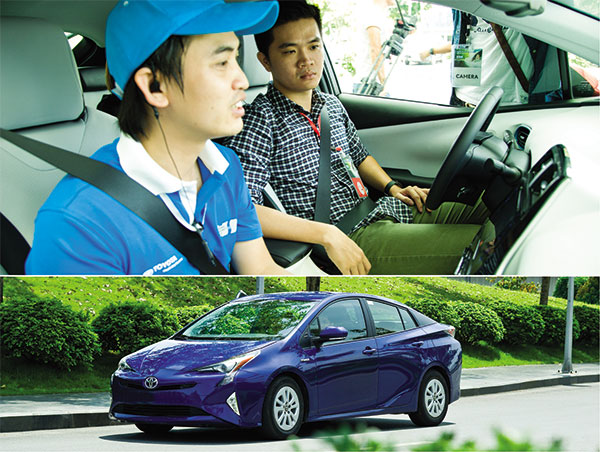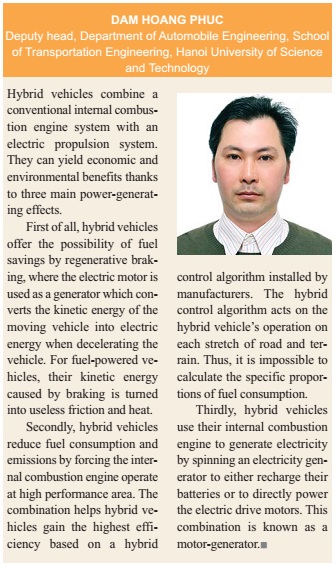Rigid taxes hurt hybrids’ mass appeal
Impractical tax incentives
 |
Preliminary statistics indicate that in early 2017, global sales of hybrid electric vehicles amounted to 12 million units. Japan ranked first in terms of the sales of hybrid vehicles, followed by the US and the EU. Meanwhile, only 1,229 hybrid vehicles and seven electric units were shipped to Vietnam between January 2010 and March 2017. The number remains very small compared to the country’s annual imports of tens of thousands of petrol- or diesel-powered vehicles.
In fact, there is a lack of in-depth understanding of hybrid vehicles in Vietnam, as no legal documents point out a specific definition of these green vehicles. The Law on Special Consumption Tax, which was unified in the National Assembly Office’s Document No. 02/VBHN-VPQH dated April 28, 2016, specifies three vehicle types favoured by separate tariff rates.
The first type are vehicles which operate on an internal combustion engine system combined with an electric propulsion system, with petrol consumption accounting for maximum 70 per cent of the total power. This vehicle type is subject to tariffs 30 per cent lower than those of conventional fuel-powered vehicles.
Secondly, vehicles powered by biological energy are taxed 50 per cent less than conventional fuel-powered vehicles.
Thirdly, electric vehicles are taxed 85-95 per cent lower than conventional fuel-powered vehicles.
These regulations leave hybrid vehicles off the list, because specifying the fuel consumption, as required for the first type, is a big issue. A hybrid vehicle combines a conventional internal combustion engine with an electric motor. Different hybrid vehicles are each designed with their own priorities and allocations of petrol and electric power. Moreover, other elements – including the stretch of road, the terrain, and usage – impact fuel consumption.
Some hybrid vehicles, including Lexus H1, Toyota Prius, Camry Hybrid, and Honda Insight, as well as those operated by fossil fuel-generated electric motors, are not subject to the tariffs set for the first type of vehicle mentioned above. Such car types are not powered by petrol in combination with electric power, because the electric power is completely recharged from the operations of the internal combustion engine system, the Ministry of Finance (MoF) stated in a document sent to the National Assembly Committee on Science, Technology, and Environment.
 |
| Imported hybrid vehicles are not subject to the tariff cut of 30 per cent as prescribed in the Law on Special Consumption Tax |
Benefits of hybrids
Green vehicles are essentially designed with engines that generate fewer emissions and environmental impacts than petrol- or diesel-powered vehicles do. They operate either fully on alternative energy or on fossil fuel in combination with alternative energy.
Hybrid units are some of the world’s most popular green vehicles thanks to the considerable benefits they can bring.
Green vehicles have been found to generate considerable environmental and economic benefits. According to the International Energy Agency’s Committee on Energy Research and Technology, vehicle emissions are the major cause of climate change. Emissions generated from road vehicles are responsible for large shares of total carbon emissions. In the US, up to 33 per cent of total emissions come from vehicles, while the same ratio in Britain is 20 per cent.
 |
Vietnam has not released specific statistics on vehicle emissions. But it is not difficult to imagine how serious of an issue vehicle emissions are, especially in major cities. For a long time, the country accepted the flow of engines meeting only Euro 2 and 3 emission standards before the application of Euro 4 standard for petrol-powered vehicles took effect last year and the delayed Euro 4 application for diesel-powered engines started on January 1 this year.
Green vehicles can help slash vehicle emissions, which are linked directly to human illnesses, such as respiratory and cardiopulmonary disease and lung cancer. The World Health Organisation reported that Europe annually registers up to 13,000 deaths of children below the age of four that are attributable to outdoor pollution. If pollution levels are kept within EU limits, more than 5,000 of these young lives could be saved per year.
Although green vehicles are more expensive than many conventional internal combustion engines, they can help reduce fuel consumption. For instance, the 2016 Toyota Prius model was expected to average 2.5 litres per 100 km, much lower than the consumption of petrol-powered Toyota sedans, which ranges from six to nine litres.
In a bid to further the use of green vehicles, many countries have approved hybrids and plug-in hybrids as green vehicles and even provided them with tax incentives. China, Malaysia, and other ASEAN countries are working on fostering the use of environmentally-friendly vehicles.
Some countries have expanded the list to those complying or surpassing the more stringent Euro 6 emission standards or the US state of California’s zero-emission vehicle standards. In a drastic move, Britain and France last July approved a ban on the sale of petrol- and diesel-powered vehicles starting in 2040, so as to reduce the use of internal combustion engines.
In contrast, the MoF statement on hybrid vehicles seems to have overlooked the economic and environmental benefits hybrid use could result in. This is incompatible with international practices and Vietnam’s green growth strategy for 2020. Under the plan, the country – one of the 10 countries most vulnerable to effects caused by climate change – set a target of reducing greenhouse gas emissions, enhancing the use of alternative energy, and cutting down on energy consumption in transportation.
As a result, hybrid vehicles imported to Vietnam are not subject to the tariff cut of 30 per cent as prescribed in the Law on Special Consumption Tax. This emerges as a barrier to lure investments in the domestic manufacture and assembly of hybrid vehicles and to push their use.
Taxation is not only a main source of revenue for the state budget, but also a tool to stimulate economic growth, adjust the provision of goods, and ensure social stability. Appropriate and practical tax incentives set for each product and industry will give an impetus to the growth.
While Vietnam is lacking electric charging stations, hybrid vehicles are still a good choice for users wary of plug-in hybrid and electric vehicles.
Given these facts, rational and practical incentives as opposed to mechanical regulations should be a crucial part of a blueprint set for the growth of green vehicle use.
What the stars mean:
★ Poor ★ ★ Promising ★★★ Good ★★★★ Very good ★★★★★ Exceptional
Latest News
More News
- Development highlights in Q1 through expert’s lenses (April 08, 2024 | 16:48)
- Vietnam logs 17.1 million business cyberthreats in 2023 (April 08, 2024 | 16:34)
- Vietnam now China's top ASEAN trading partner (April 08, 2024 | 16:26)
- Vietnamese businesses grapple with surging exchange rates (April 08, 2024 | 09:59)
- PM outlines 10 socioeconomic achievements in first quarter (April 04, 2024 | 08:00)
- Implementation strategy for new power development plan approved (April 03, 2024 | 15:14)
- Wood sector sees signs of recovery (April 02, 2024 | 06:56)
- Ba Ria-Vung Tau received major investment boost in Q1 (March 29, 2024 | 17:22)
- More chinese solar-tech manufacturers enter Vietnam (March 29, 2024 | 16:10)
- Canadian businesses focus on green energy and agriculture in Vietnam (March 29, 2024 | 10:04)


















 Mobile Version
Mobile Version